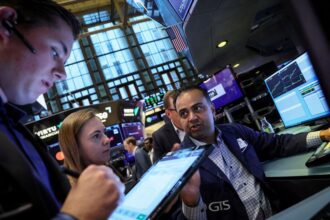Campbell Harvey, a Duke University finance professor best known for developing the yield-curve recession indicator, says the Federal Reserve’s read on inflation is out of whack; and as a result, it’s increasing the likelihood that the U.S. slips into a recession.
The big question now is the severity of the economic downturn to come, if the central bank continues unabated on its high-interest rate path.
On Wednesday, the Fed, which began raising rates from near zero last year, held them at a range of 5.25% to 5.5%, a 22-year-year high, in its effort to combat out-of-control inflation.
“The [inflation gauge] that the Fed uses makes no sense whatsoever and it’s totally disconnected from market conditions,” Harvey told MarketWatch in a phone interview.
The Fed’s measures of inflation are heavily weighted toward shelter costs, which refers to the rising price of rental and owner-occupied housing. For example, shelter inflation showed a 7.3% increase over the past 12 months, also as of the most recent consumer price index for August. Shelter represents around 40% of the core CPI reading.
Harvey says that’s a problem because shelter’s retreat loosely follows the broader trend lower for headline inflation but at a lag, and the Fed wouldn’t be properly accounting for that lag if it decided to keep rates restrictively high.
Separately, MarketWatch’s economics reporter, Jeff Bartash, notes that CPI also fails to capture the millions of Americans who locked in low mortgage rates before or during the pandemic and who are now paying less for housing.
“The Fed is … using inflation, in what I call, a false narrative,” Harvey said.
Harvey said if shelter inflation was normalized at around a rise of 1% or 1.5%, then overall core inflation would measure closer to 1.5% or 2%. In other words, at or substantially below, the Fed’s 2% target.
Consumer prices ex shelter grew 1.9% year-over-year in August, up from 1% in July, according to the Labor Department.
The Canadian-born Duke professor says that the Fed risks driving the U.S. economy into recession because it has achieved its goal of taming inflation, which hovered around 9% at its peak, but it isn’t making it clear that its rate hikes are complete .
“Now, the higher those rates go the worse [the recession] is,” he said.
Harvey pioneered the idea that an inverted yield curve is a recession indicator, with the inversion involving the yield on three-month Treasury-bills, rising above the rate on the 10-year Treasury note
BX:TMUBMUSD10Y.
Longer-term Treasurys typically have higher yields than shorter-term U.S. government debt; the inversion of that relationship historically has predicted economic contractions.
Harvey says that that his yield-curve inversion model has an unblemished track record, 8-out-of-8, for predicting recessions, over the past 70 years. A recent inversion of U.S. yield curves implies that a U.S. recession is still possible.
On Thursday, the Dow Jones Industrial Average
DJIA
fell 1.1%, while the S&P 500
SPX
tumbled1.6% and the Nasdaq Composite
COMP
fell 1.8%, marking one of the worst days for stocks in months.
Read the full article here








